Member Comments
No comments so far
 One good tip that a solid online poker pro continually gives on his blog is to look through hands in a Hold’em Manager or PokerTracker database. He says to break down your play and run hands through PokerStove or Pokerazor in order to see the mathematical side of poker and reveal whether or not you got your money in good. Are you getting enough equity making tough calls at the river? These questions can be answered by using either of these programs, which utilize more than just simple, general purpose algorithms to perform odds calculations. Both programs feature an evaluator that fully enumerates complex situations, but which one is better? Let’s take a look.
One good tip that a solid online poker pro continually gives on his blog is to look through hands in a Hold’em Manager or PokerTracker database. He says to break down your play and run hands through PokerStove or Pokerazor in order to see the mathematical side of poker and reveal whether or not you got your money in good. Are you getting enough equity making tough calls at the river? These questions can be answered by using either of these programs, which utilize more than just simple, general purpose algorithms to perform odds calculations. Both programs feature an evaluator that fully enumerates complex situations, but which one is better? Let’s take a look.
Point 1: Cost
PokerStove has a cost of zero dollars. This freeware application can be readily downloaded (currently version 1.21) from the website and works within the Windows operating system. Installing and running the program is an absolute cinch and can easily be used by any poker novice.
Pokerazor is also currently free to download and use. There are plans for future editions of the program to have free areas, while others will require a purchase to access. For now, it’s free and can be easily downloaded and installed.
Winner: Draw
Point 2: Features
Oddly enough, both websites have a complete lack of a feature bullet point list for users to see what the program does. What we’ve done is load up both programs and list out what you can do. Both programs only analyze Texas Hold’em hands.
PokerStove: The program is really straightforward and allows a user to have up to 10 players in the hand analysis. A user enters in their specific hands or their ranges and presses the “Evaluate” button. After the calculations are completed, the equity for each player’s hand is given. Once you are done, you can save the analysis as a .pst file (specific to PokerStove) and then load it up later.
Pokerazor: This program offers a bit more. When it loads up, there’s a game configuration tool that can recreate hand situations and evaluate decisions made on all streets. Within the program, there is a Range Exploration tool which works similarly to PokerStove, only it is confined to work between you and one villain. Within the “Examples” area, you can see what you can do if you go through the entire configuration process and create quizzes for yourself designed to target certain types of players (a calling station comes pre-built as an example).
Winner: Pokerazor
Point 3: Graphics and Interface Design
PokerStove: This is a no frills design in terms of graphical aesthetics. It looks like an old Visual Basic program from the year 1992 and has all the charm of a funeral parlor. What it lacks in design, it makes up for in pure function. The buttons are laid out in a way such that it is easy to perform actions very quickly. The “cards” are four colored (which lets you find them faster) and the hand distribution chart is laid out neatly. The equity box when the calculations are completed has been color coded to show the advantage it has over the opponents. Overall, this is purely function over beauty.
Pokerazor: This is a program with an upgraded graphical user interface and looks more like a program created for the Windows XP+ environments. The buttons are all easy to find as well, specifically when you just use the Range Explorer, which will be a vast majority of your time within the program. The cards are also color coded, but have much larger buttons, making them easier to press without making a mistake. Once the calculations are made, there are graphs that come up for frequency and cumulative frequency showing a distribution of where the villain’s hand would land. Overall, the graphics of Pokerazor are decent, but nothing special.
Winner: Pokerazor
Point 4: Function
PokerStove: This program is made for you folks who probably want to use it during a session. It’s quick, clean, no frills, and gives your answers quickly even against multiple opponents. You get the immediate answer on equity you need in a short manner of time.
Pokerazor: Although there are many different uses, the main thrust of the program is within the Range Explorer. This, too, can be really easy to use and, if necessary, employed while you are in a hand. It’s perfect for a situation where you have a really tough decision to make and the math might be beyond your immediate comprehension. The good news with this is that you don’t just get the equity, but also the frequency of where your opponent’s hand might be. If you click on “My hand strength distribution,” you can actually see how often your hand is best as well as your equity.
Winner: Pokerazor
Final Analysis
Although users of PokerStove aren’t really missing out on much if they are not moving to Pokerazor, there’s much to be said for moving over to the newer and flashier product. Specifically within the Range Exploration tool (which directly competes with the entire PokerStove program), there’s a lot more to learn with Pokerazor, making it the hand analysis tool of choice.
Check out our PokerStove and Pokerazor reviews right here on PokerSoftware.com.
No comments so far